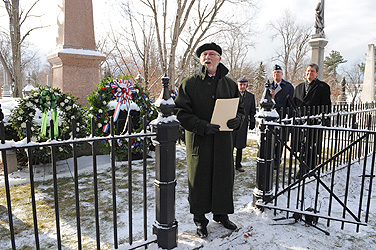News
Simpson gives annual Fillmore address

John B. Simpson is only the second UB president to deliver the address at the annual Millard Fillmore commemoration. Photo: NANCY J. PARISI
As his tenure as UB’s 14th president gradually comes to an end, John B. Simpson took time last Friday to honor the university’s first leader, Millard Fillmore, at the Fillmore family gravesite in Forest Lawn Cemetery in a ceremony that dates back to the 1930s.
Born on Jan. 7, 1800, Fillmore was UB’s first chancellor, serving from 1847 until his death in 1874. He also was the 13th U.S. president from 1850 to 1853, and helped establish many well-known Buffalo institutions, including the Buffalo Museum of Science, Albright-Knox Art Gallery and the Buffalo Club, in addition to UB.
Simpson originally had planned to retire from UB on Jan. 15, but agreed to stay on as president while the search for his successor moves toward a conclusion. As he prepares to leave Buffalo to be with family in his former hometown of Seattle, it is only fitting, he said, that he pause to honor a man who never failed to recognize the value of his own hometown.
Simpson was only the second UB president to deliver the address at the annual Fillmore commemoration—Robert Ketter spoke in 1971. In 1966, what had been an annual event run by the city of Buffalo and the Buffalo Board of Education celebrating Fillmore’s birth (“not death,” pointed out Joe Dispenza, Buffalo Club president) was turned over to UB, which began sending a different administrator to give the memorial address each year.
This year, the 211th observance was held on a bitterly cold but clear morning, with bright sunshine and fresh snow from the night before sparkling on tree branches. The ceremony began with a presentation of flags by three lieutenants from UB Police Color Guard, followed by a welcome by William Regan, UB director of special events. Joel Miller, senior minister at the Unitarian Universalist Church of Buffalo, gave a brief invocation, and then four wreaths were dedicated and placed by the Fillmore obelisk by representatives from the White House, UB’s Millard Fillmore College, and event co-hosts from the Buffalo Club and Forest Lawn.
Fillmore, Simpson said, realized that “you can’t have a strong community without having strong public institutions” and recognized education’s value to society.
In Fillmore’s time, Simpson continued, UB was a small, local, medical school, but he saw the potential for a great public university serving the entire state. As well, Simpson sees in Buffalo the promise of a city that can transcend its industrial past. “I firmly believe that we are at the brink of a new era and that UB plays a pivotal role,” he said, noting the university’s contributions to “providing equitable opportunities for all citizens” and “transforming Buffalo into a knowledge-based economy.”
Attendees from the community included all 15 schoolchildren from the Mandala School, a tiny private school in East Aurora, Fillmore’s former hometown. Mandala recently purchased the circa-1830s house adjacent to Fillmore’s parents’ former residence. Apple-cheeked from the cold, kids from grades 4 to 7 stood in rapt attention throughout the ceremony. Their instructors and mothers—many of whom had UB connections—said they’d been researching Fillmore for weeks, learning about his political accomplishments, civic contributions and even some fun trivia. (Barb Haney, a Mandala co-teacher, pointed out that Fillmore installed the first bathroom in the White House.)
“I didn’t know he had founded so many things,” said fourth-grader Chris Maloney, enjoying a day off school with his classmate, Sebastian Brown.
“I like being able to celebrate my birthday this way,” added 12-year-old Hannah Willick, who was happy to share her day with Fillmore.
Veteran supporters included co-organizers and history buffs from UB, the Abigail Fillmore Chapter of the Daughters of the American Revolution and the Buffalo and Erie County Historical Society, which holds one of the largest collections of Fillmore papers in the country.
After Simpson’s address, UB marching band member West Richter performed “Taps” on the trumpet, and the crowd reconvened in the Forest Lawn chapel to mingle over hot drinks and cookies. Simpson greeted guests by the crackling fire, trading farewell wishes and recollections of his UB career—and marking a quintessentially Buffalo experience he says he won’t soon forget.
“For me, this has been something in the back of my mind to do for a while now,” Simpson said about the commemoration. “It’s something singular and unique that our first chancellor was a U.S. president, and worth celebrating.”

Reader Comments